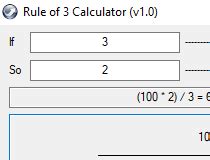The rule of 3, also known as the unitary method, is a fundamental mathematical concept used to solve proportions and equivalent ratios. It involves finding the value of an unknown quantity by comparing it to three known quantities and establishing a proportional relationship among them.

With the help of a rule of 3 calculator, you can effortlessly perform these calculations, saving time and reducing the risk of errors. Here’s a comprehensive guide to help you understand how it works:
How to Use a Rule of 3 Calculator
Using a rule of 3 calculator is straightforward. Simply input the three known quantities and the unknown quantity you wish to solve for. The calculator will then display the result instantly.
For example, suppose you have a recipe that calls for 2 cups of flour to make 12 cupcakes. You want to know how many cups of flour you need to make 36 cupcakes. Using the rule of 3 calculator, you would enter the following:
- Known quantity 1: 2 cups of flour
- Known quantity 2: 12 cupcakes
- Known quantity 3: 36 cupcakes
- Unknown quantity: X (cups of flour)
The calculator would then calculate and display the result, which is 6 cups of flour.
Benefits of Using a Rule of 3 Calculator
1. Accuracy and Efficiency: Rule of 3 calculators eliminate the need for manual calculations, reducing the risk of errors and significantly speeding up the process.
2. Simplifies Complex Calculations: The calculator handles the proportional relationships and calculations internally, making it easy to solve even the most complex problems.
3. Time-Saving: By automating the calculations, the calculator frees up your time to focus on other tasks or concepts.
Common Mistakes to Avoid
1. Not Understanding the Concept: It is essential to have a clear understanding of the rule of 3 before using the calculator. This will ensure you interpret the results correctly.
2. Incorrect Input: Double-check the values you enter into the calculator to avoid errors.
3. Misinterpreting the Result: Pay attention to the units of the result displayed by the calculator. Ensure it aligns with the context of your problem.
Why the Rule of 3 Matters
The rule of 3 finds applications in various fields, including:
- Engineering: Calculating material quantities for construction or manufacturing.
- Finance: Determining profit margins, interest rates, and loan payments.
- Science: Converting units, calculating concentrations, and predicting reaction rates.
- Everyday Life: Estimating ingredients for recipes, calculating conversion rates, and making comparisons.
6 FAQs about the Rule of 3 Calculator
1. What types of problems can the calculator solve?
The rule of 3 calculator can solve various problems involving proportions and equivalent ratios.
2. Is it reliable?
Yes, the calculator uses mathematical algorithms to ensure accurate results.
3. Can I use the calculator for any value?
The calculator can handle both positive and negative values, as well as fractions and decimals.
4. How can I troubleshoot errors?
Check your input values and ensure they are correct and within the appropriate range.
5. Are there limitations to the calculator?
The calculator cannot solve problems where the proportional relationship is not linear.
6. What is the creative new word to generate ideas for new applications of the calculator?
“Proportionator”
Tables for a Comprehensive Understanding
Table 1: Common Applications of the Rule of 3
| Field | Application |
|---|---|
| Engineering | Calculating material quantities |
| Finance | Determining profit margins |
| Science | Converting units |
| Everyday Life | Estimating ingredients for recipes |
Table 2: Benefits of Using a Rule of 3 Calculator
| Benefit | Description |
|---|---|
| Accuracy and Efficiency | Eliminates errors and speeds up calculations |
| Simplifies Complex Calculations | Handles proportional relationships internally |
| Time-Saving | Frees up time for other tasks |
Table 3: Common Mistakes to Avoid when Using a Rule of 3 Calculator
| Mistake | Description |
|---|---|
| Not Understanding the Concept | Leads to incorrect interpretations |
| Incorrect Input | Errors in calculations |
| Misinterpreting the Result | Units may not align with the context |
Table 4: FAQs about the Rule of 3 Calculator
| Question | Answer |
|---|---|
| What types of problems can it solve? | Proportion and equivalent ratio problems |
| Is it reliable? | Yes, based on mathematical algorithms |
| Can I use it for any value? | Accepts positive and negative values, fractions, and decimals |
| Troubleshooting errors | Check input values and ensure correctness |
